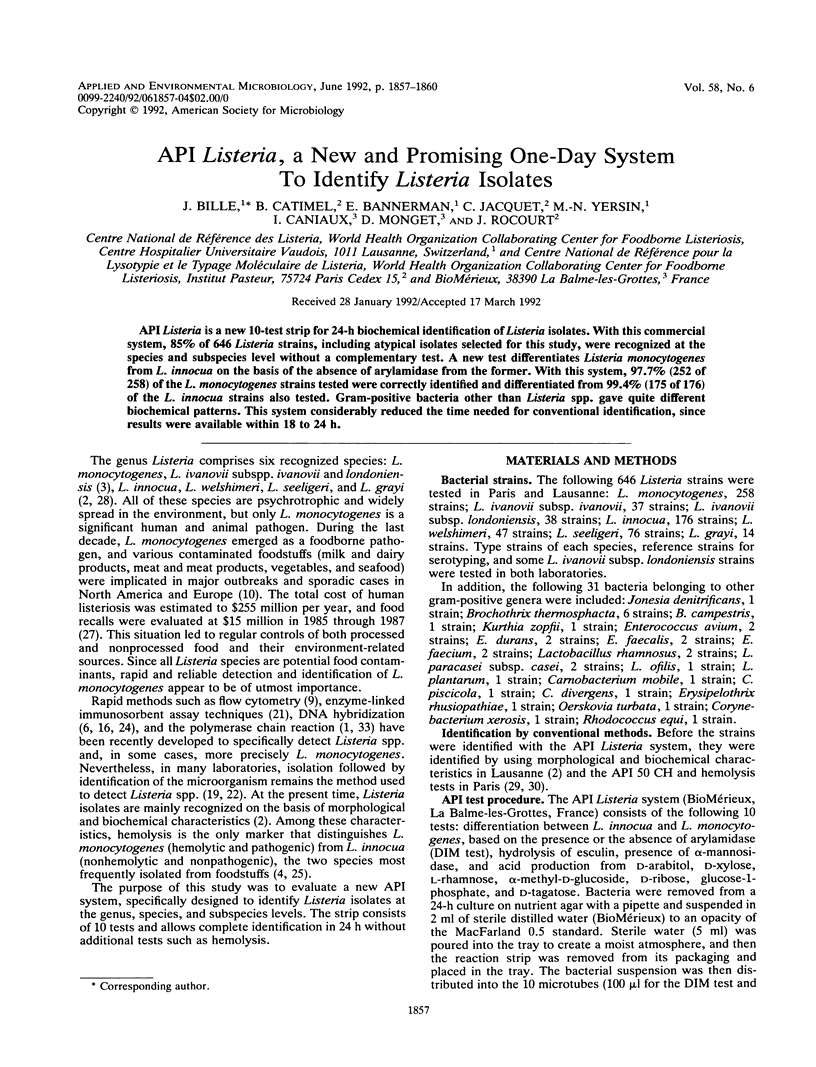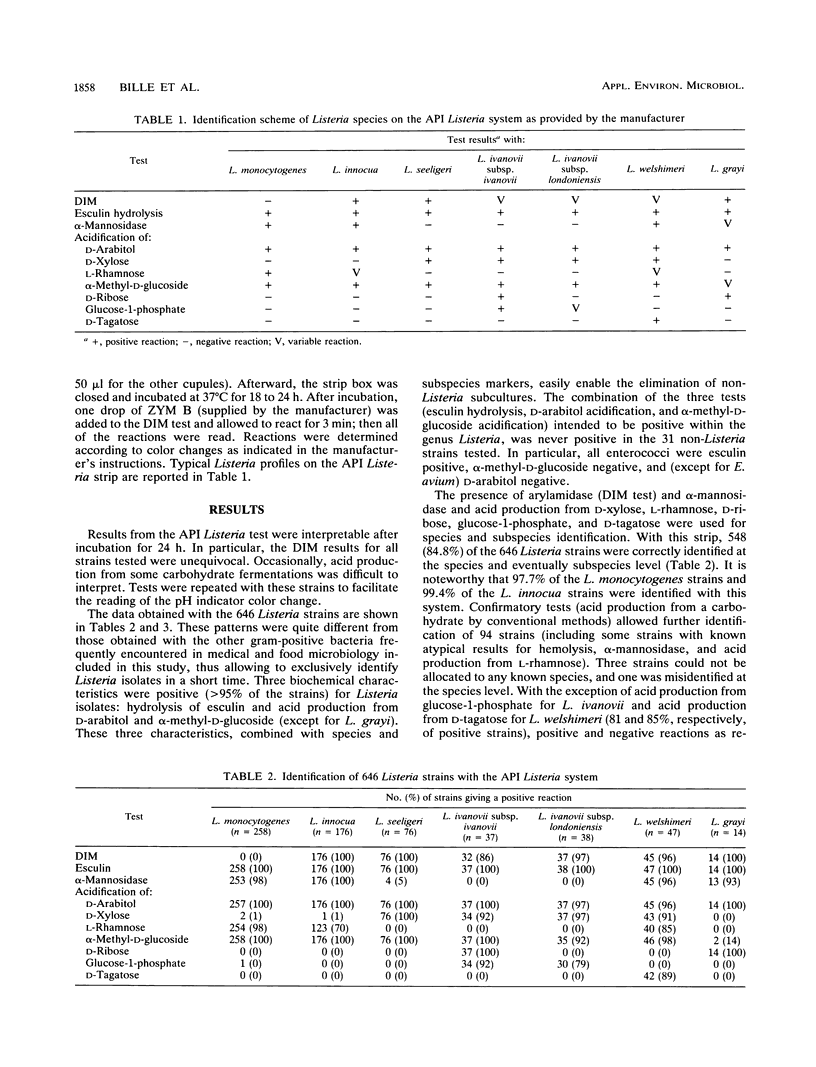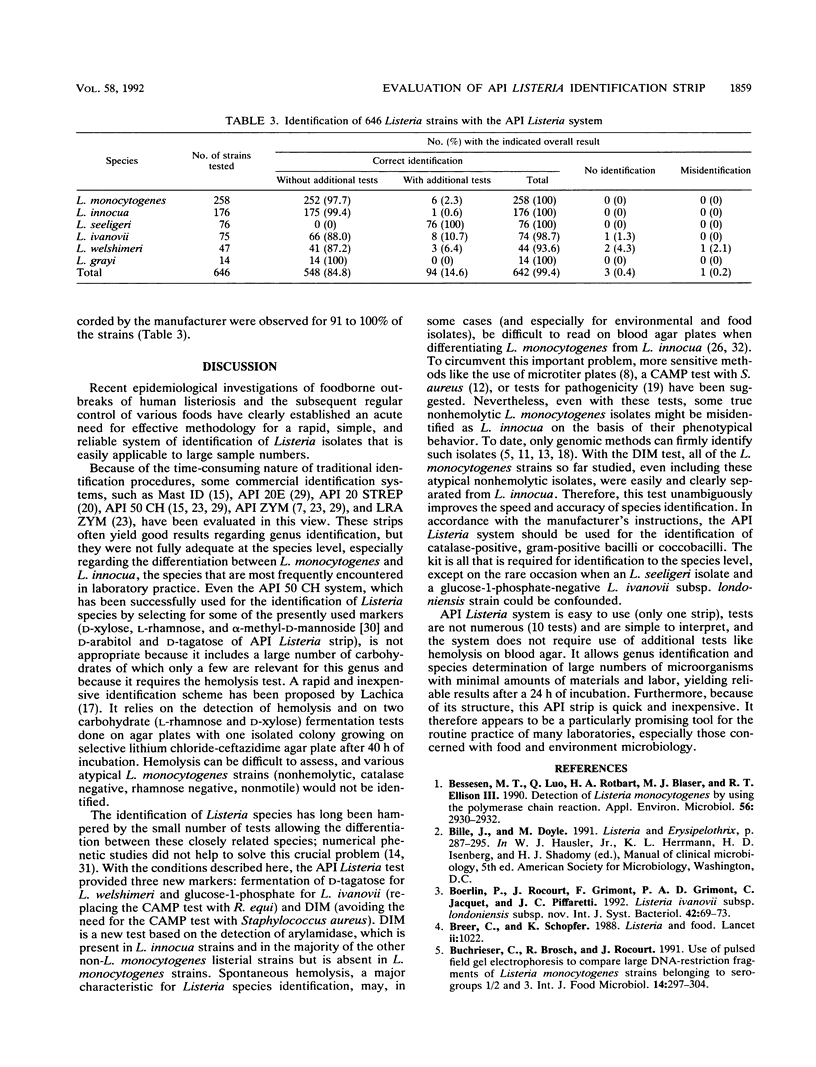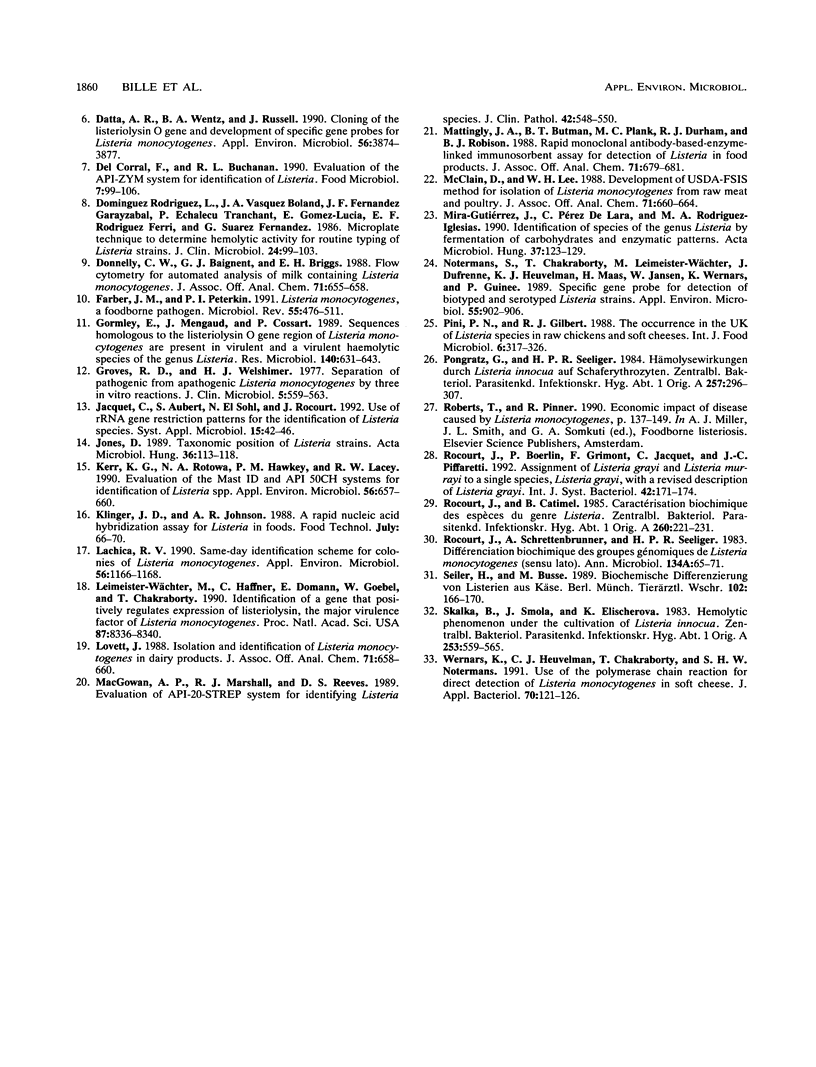Abstract
API Listeria is a new 10-test strip for 24-h biochemical identification of Listeria isolates. With this commercial system, 85% of 646 Listeria strains, including atypical isolates selected for this study, were recognized at the species and subspecies level without a complementary test. A new test differentiates Listeria monocytogenes from L. innocua on the basis of the absence of arylamidase from the former. With this system, 97.7% (252 of 258) of the L. monocytogenes strains tested were correctly identified and differentiated from 99.4% (175 of 176) of the L. innocua strains also tested. Gram-positive bacteria other than Listeria spp. gave quite different biochemical patterns. This system considerably reduced the time needed for conventional identification, since results were available within 18 to 24 h.
Full text
PDF



Selected References
These references are in PubMed. This may not be the complete list of references from this article.
- Bessesen M. T., Luo Q. A., Rotbart H. A., Blaser M. J., Ellison R. T., 3rd Detection of Listeria monocytogenes by using the polymerase chain reaction. Appl Environ Microbiol. 1990 Sep;56(9):2930–2932. doi: 10.1128/aem.56.9.2930-2932.1990. [DOI] [PMC free article] [PubMed] [Google Scholar]
- Breer C., Schopfer K. Listeria and food. Lancet. 1988 Oct 29;2(8618):1022–1022. doi: 10.1016/s0140-6736(88)90775-1. [DOI] [PubMed] [Google Scholar]
- Buchrieser C., Brosch R., Rocourt J. Use of pulsed field gel electrophoresis to compare large DNA-restriction fragments of Listeria monocytogenes strains belonging to serogroups 1/2 and 3. Int J Food Microbiol. 1991 Dec;14(3-4):297–304. doi: 10.1016/0168-1605(91)90121-5. [DOI] [PubMed] [Google Scholar]
- Datta A. R., Wentz B. A., Russell J. Cloning of the listeriolysin O gene and development of specific gene probes for Listeria monocytogenes. Appl Environ Microbiol. 1990 Dec;56(12):3874–3877. doi: 10.1128/aem.56.12.3874-3877.1990. [DOI] [PMC free article] [PubMed] [Google Scholar]
- Dominguez Rodriguez L., Vazquez Boland J. A., Fernandez Garayzabal J. F., Echalecu Tranchant P., Gomez-Lucia E., Rodriguez Ferri E. F., Suarez Fernandez G. Microplate technique to determine hemolytic activity for routine typing of Listeria strains. J Clin Microbiol. 1986 Jul;24(1):99–103. doi: 10.1128/jcm.24.1.99-103.1986. [DOI] [PMC free article] [PubMed] [Google Scholar]
- Donnelly C. W., Baigent G. J., Briggs E. H. Flow cytometry for automated analysis of milk containing Listeria monocytogenes. J Assoc Off Anal Chem. 1988 May-Jun;71(3):655–658. [PubMed] [Google Scholar]
- Farber J. M., Peterkin P. I. Listeria monocytogenes, a food-borne pathogen. Microbiol Rev. 1991 Sep;55(3):476–511. doi: 10.1128/mr.55.3.476-511.1991. [DOI] [PMC free article] [PubMed] [Google Scholar]
- Gormley E., Mengaud J., Cossart P. Sequences homologous to the listeriolysin O gene region of Listeria monocytogenes are present in virulent and avirulent haemolytic species of the genus Listeria. Res Microbiol. 1989 Nov-Dec;140(9):631–643. doi: 10.1016/0923-2508(89)90195-2. [DOI] [PubMed] [Google Scholar]
- Groves R. D., Welshimer H. J. Separation of pathogenic from apathogenic Listeria monocytogenes by three in vitro reactions. J Clin Microbiol. 1977 Jun;5(6):559–563. doi: 10.1128/jcm.5.6.559-563.1977. [DOI] [PMC free article] [PubMed] [Google Scholar]
- Jones D. Taxonomic position of Listeria strains. Acta Microbiol Hung. 1989;36(2-3):113–118. [PubMed] [Google Scholar]
- Kerr K. G., Rotowa N. A., Hawkey P. M., Lacey R. W. Evaluation of the Mast ID and API 50CH systems for identification of Listeria spp. Appl Environ Microbiol. 1990 Mar;56(3):657–660. doi: 10.1128/aem.56.3.657-660.1990. [DOI] [PMC free article] [PubMed] [Google Scholar]
- Lachica R. V. Same-day identification scheme for colonies of Listeria monocytogenes. Appl Environ Microbiol. 1990 Apr;56(4):1166–1168. doi: 10.1128/aem.56.4.1166-1168.1990. [DOI] [PMC free article] [PubMed] [Google Scholar]
- Leimeister-Wächter M., Haffner C., Domann E., Goebel W., Chakraborty T. Identification of a gene that positively regulates expression of listeriolysin, the major virulence factor of listeria monocytogenes. Proc Natl Acad Sci U S A. 1990 Nov;87(21):8336–8340. doi: 10.1073/pnas.87.21.8336. [DOI] [PMC free article] [PubMed] [Google Scholar]
- Lovett J. Isolation and identification of Listeria monocytogenes in dairy products. J Assoc Off Anal Chem. 1988 May-Jun;71(3):658–660. [PubMed] [Google Scholar]
- MacGowan A. P., Marshall R. J., Reeves D. S. Evaluation of API 20 STREP system for identifying Listeria species. J Clin Pathol. 1989 May;42(5):548–550. doi: 10.1136/jcp.42.5.548. [DOI] [PMC free article] [PubMed] [Google Scholar]
- Mattingly J. A., Butman B. T., Plank M. C., Durham R. J., Robison B. J. Rapid monoclonal antibody-based enzyme-linked immunosorbent assay for detection of Listeria in food products. J Assoc Off Anal Chem. 1988 May-Jun;71(3):679–681. [PubMed] [Google Scholar]
- McClain D., Lee W. H. Development of USDA-FSIS method for isolation of Listeria monocytogenes from raw meat and poultry. J Assoc Off Anal Chem. 1988 May-Jun;71(3):660–664. [PubMed] [Google Scholar]
- Mira-Gutiérrez J., Pérez de Lara C., Rodriguez-Iglesias M. A. Identification of species of the Genus listeria by fermentation of carbohydrates and enzymatic patterns. Acta Microbiol Hung. 1990;37(1):123–129. [PubMed] [Google Scholar]
- Notermans S., Chakraborty T., Leimeister-Wächter M., Dufrenne J., Heuvelman K. J., Maas H., Jansen W., Wernars K., Guinee P. Specific gene probe for detection of biotyped and serotyped Listeria strains. Appl Environ Microbiol. 1989 Apr;55(4):902–906. doi: 10.1128/aem.55.4.902-906.1989. [DOI] [PMC free article] [PubMed] [Google Scholar]
- Pini P. N., Gilbert R. J. The occurrence in the U.K. of Listeria species in raw chickens and soft cheeses. Int J Food Microbiol. 1988 Jun;6(4):317–326. doi: 10.1016/0168-1605(88)90025-6. [DOI] [PubMed] [Google Scholar]
- Pongratz G., Seeliger H. P. Hämolysewirkungen durch Listeria innocua auf Schaferythrozyten. Zentralbl Bakteriol Mikrobiol Hyg A. 1984 Aug;257(3):296–307. [PubMed] [Google Scholar]
- Rocourt J., Boerlin P., Grimont F., Jacquet C., Piffaretti J. C. Assignment of Listeria grayi and Listeria murrayi to a single species, Listeria grayi, with a revised description of Listeria grayi. Int J Syst Bacteriol. 1992 Jan;42(1):171–174. doi: 10.1099/00207713-42-1-171. [DOI] [PubMed] [Google Scholar]
- Rocourt J., Catimel B. Caractérisation biochimique des espèces du genre Listeria. Zentralbl Bakteriol Mikrobiol Hyg A. 1985 Oct;260(2):221–231. [PubMed] [Google Scholar]
- Rocourt J., Schrettenbrunner A., Seeliger H. P. Différenciation biochimique des groupes génomiques de Listeria monocytogenes (sensu lato). Ann Microbiol (Paris) 1983 Jan-Feb;134A(1):65–71. [PubMed] [Google Scholar]
- Seiler H., Busse M. Biochemische Differenzierung von Listerien aus Käse. Berl Munch Tierarztl Wochenschr. 1989 May 1;102(5):166–170. [PubMed] [Google Scholar]
- Skalka B., Smola J., Elischerová K. Hemolytic phenomenons under the cultivation of Listeria innocua. Zentralbl Bakteriol Mikrobiol Hyg A. 1983 Feb;253(4):559–565. [PubMed] [Google Scholar]
- Wernars K., Heuvelman C. J., Chakraborty T., Notermans S. H. Use of the polymerase chain reaction for direct detection of Listeria monocytogenes in soft cheese. J Appl Bacteriol. 1991 Feb;70(2):121–126. doi: 10.1111/j.1365-2672.1991.tb04437.x. [DOI] [PubMed] [Google Scholar]


